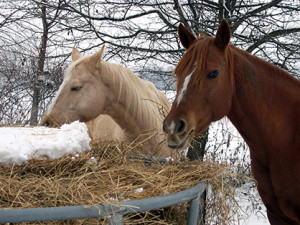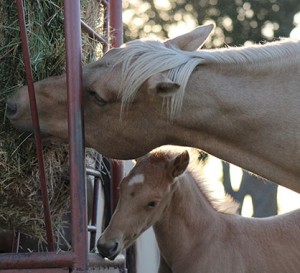Are You Ready For Winter? Part 1- Stocking Up on Hay
By: Megan Arszman
For some, the colder temperatures signal the start of hibernation—it might be for just a few weeks of vacation after the hustle and bustle of the year-end shows are complete or a few months of an extended break until the days get longer and brighter. However you choose to celebrate winter, you want to make sure your expensive equipment, horse, and maybe even yourself, is prepared to handle the weather and be ready to hop back into work when the time comes.
Did you know that the average 1,000 pound horse, that gets moderate exercise, needs about 20 pounds of hay per day? Add up the days, and you’re looking at 2,000 pounds of hay to last one horse about three months. Do you have enough hay to keep your horse going through the winter?
Know What You’re Buying
Not just any hay will do—you need to know what to look for when buying hay for your horses this winter. You want to make sure you’re spending your hard-earned money on quality hay that has high-nutrient content, is free of dust, mold, and other foreign matter, and is suitable for your horse’s needs.
Activity Level
Take into account your horse’s activity level over the winter months. Are you still going to be exercising your horse on a regular basis or is he on vacation until the temperatures warm up? Is your mare pregnant? Also, you want to be familiar with how much crude protein is in your hay—forage cut in early maturity or that has a high leaf-to-stem ration has a higher crude protein percentage than one that is stemmier or cut later. According to America’s Alfalfa, crude protein percentage indicates the capacity of the feed to meet your horse’s protein needs. You also want to look at the digestibility of your horse’s hay.
First or Third Cutting?
Experts agree that horse owners should not be overly concerned with which cutting hay comes from. Whether it’s a first cutting or third, hay from any cutting can either be good or bad. It all depends on the maturity of the forage when it was cut and how well it was stored after bailing. You can ask your hay dealer for information about the stage of maturity when the forage was baled and for an analysis of hay quality.
Your local agriculture extension office might offer free hay testing if you are interested in seeing the quality of hay you either have now or are interested in purchasing.
Proper Storage
When storing hay, make sure the storage area is dry and that hay will be protected from rain and snow. Using pallets on the floor on which to stack hay bales will help keep the bottom layer of hay from absorbing moisture from the ground. You can cover outdoor bales with plastic tarps; just make sure the covering is tied down so the wind can’t lift it up. Keep the storage area relatively rodent free to help decrease any potential inter-species contamination issues.













